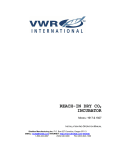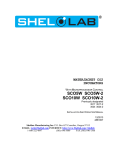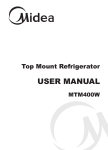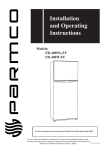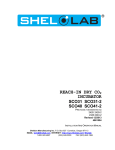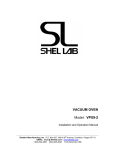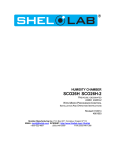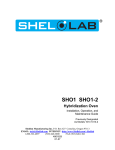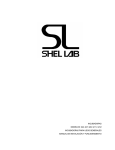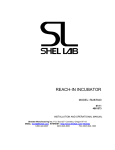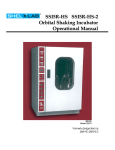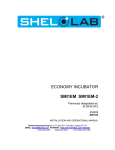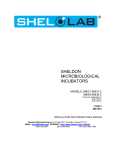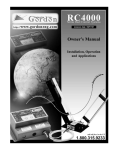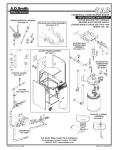Download User Manual - Spectra Services
Transcript
INCUBATOR MODEL: SSI3 / SSI3-2 Previously designated as SI4 / SI4-2 ORBITAL SHAKING INCUBATOR INSTALLATION AND OPERATIONAL MANUAL 11/2013 4861492 Sheldon Manufacturing Inc. P.O. Box 627 Cornelius, Oregon 97113 EMAIL: [email protected] INTERNET: http://www.Shellab.com/~Shellab 1-800-322-4897 (503) 640-3000 FAX (503) 640-1366 TABLE OF CONTENTS SECTION 1.0 RECEIVING AND INSPECTION SECTION 2.0 GRAPHIC SYMBOLS SECTION 3.0 INSTALLATION SECTION 4.0 CONTROL OVERVIEW SECTION 5.0 OPERATION SECTION 6.0 MAINTENANCE SECTION 7.0 TROUBLESHOOTING SECTION 8.0 PARTS LIST SECTION 9.0 SPECIFICATIONS WIRE DIAGRAM These units are TUV CUE listed as orbital shaking incubators for professional, industrial, or educational use where the preparation or testing of materials is done at approximately atmospheric pressure and no flammable, volatile, or combustible materials are being heated. These units have been tested to the following requirements: CAN/CSA C22.2 No. 61010-1:2012 CAN/CSA C22.2 No. 61010-2-010 + R:2009 UL 61010-1:2004 + R:2005-07 + R:2008-10 UL 61010A-2-010:2002 UL 61010-1:2012 EN 61010-1:2010 EN 61010-2-010:2003 IEC 61010-1:2010 IEC 61010-2-010:2003 2 1 Section RECEIVING AND INSPECTION Your satisfaction and safety require a complete understanding of this unit. Read the instructions thoroughly and be sure all operators are given adequate training before attempting to put the unit in service. NOTE: This equipment must be used only for its intended application; any alterations or modifications will void your warranty. 1.1 Inspection: The carrier, when accepting shipment, also accepts responsibility for safe delivery and is liable for loss or damage. On delivery, inspect for visible exterior damage, note and describe on the freight bill any damage found, and enter your claim on the form supplied by the carrier. 1.2 Inspect for concealed loss or damage on the unit itself, both interior and exterior. If necessary, the carrier will arrange for official inspection to substantiate your claim. 1.3 Return Shipment: Save the shipping crate until you are sure all is well. If for any reason you must return the unit, first contact your customer representative for authorization. Supply nameplate data, including model number and serial number. 1.4 Verify that all of the equipment indicated on the packing slip is included with the unit. Carefully check all packaging before discarding. These units are equipped with 1 sample tray and 4 leveling feet. 3 2 Section GRAPHIC SYMBOLS Graphic symbols on the incubator have the following meanings. 2.1 Indicates that you should consult your manual for further description or discussion of a control or user item. 2.2 Indicates “Temperature”. 2.3 Indicates “Overtemperature Safety”. 2.4 C Indicates “Degrees Centigrade”. 2.5 Indicates “AC Power”. 2.6 Indicates “Manual Adjustable Components”. 2.7 Indicates “Oscillator”. 2.8 Indicates “Unit should be recycled” (Not disposed of in land-fill) 4 3 Section INSTALLATION Local city, county or other ordinances may govern the use of this equipment. If you have any questions about local requirements, please contact the appropriate local agency. Installation may be performed by the end user. Under normal circumstances this unit is intended for use indoors, at room temperatures between 5 and 40C, at no greater than 80% Relative Humidity (at 25C) and with a supply voltage that does not vary by more than 10%. Customer service should be contacted for operating conditions outside of these limits. 3.1 Power Source: The electrical supply circuit to the incubator must conform to all national and local electrical codes. Consult the incubator’s serial data plate for the voltage and ampere requirements before making connection. VOLTAGE SHOULD NOT VARY MORE THAN 10% FROM THE SERIAL PLATE RATING. This unit is intended for 50/60 Hz application. A separate circuit is recommended to prevent possible loss of product due to overloading or failure of other equipment on the same circuit. 3.2 Location: When selecting a site for the incubator, consider all conditions which may affect performance, such as extreme heat from steam radiators, stoves, ovens, autoclaves, etc. Avoid direct sun, fast-moving air currents, heating/cooling ducts, and high traffic areas. To ensure air circulation around the unit allow a minimum of 20 cm between the unit rear and sides and any walls or partitions which might obstruct free airflow. 3.3 Lifting / Handling: These units are heavy and care should be taken to use appropriate lifting devices that are sufficiently rated for these loads. Units should only be lifted from their bottom surfaces. Doors, handles and knobs are not adequate for lifting or stabilization. The unit should be completely restrained from tipping during lifting or transport. All moving parts, such as shelves and trays should be removed and doors need to be positively locked in the closed position during transfer to prevent shifting and damage. 3.4 Leveling: The unit must sit level and solidly. Leveling feet are supplied and must be installed in the four holes in the bottom of the unit. Turn the leveling feet counterclockwise to raise level. Adjust the foot at each corner until the unit stands level and solid without rocking. If the unit must be moved, turn the leveling feet in all the way to prevent bending and damage. 3.5 Cleaning: The incubator interior was cleaned at the factory, but not sterilized. Remove all interior parts, including shelves and shelf clips and clean with a disinfectant that is appropriate to your application. DO NOT USE chlorine-based bleaches or abrasives as this will damage the stainless steel interior. DO NOT USE spray cleaners that might leak through openings and cracks and get on electrical parts or that may contain solvents that will harm the coatings. A thorough periodic cleaning is strongly recommended. WARNING: Never clean the unit with alcohol or flammable cleaners with the unit connected to the electrical supply. Always disconnect the unit from the electrical service when cleaning and assure all volatile of flammable cleaners are evaporated and dry before reattaching the unit to the power supply. 5 4 Section CONTROL PANEL OVERVIEW 4.1 Power Switch: The main power I/O (on/off) switch controls all power to the unit and must be in the I/ON position before any systems are operational. 4.2 Main Temperature Control: Marked SET TEMP, the Main Temperature Control consists of the digital display and UP/DOWN arrow pads for inputting set point temperatures and calibration. 4.3 Over Temperature Protection (OTP) Safety Thermostat: This thermostat, labeled SAFETY TEMP, is completely independent of the Main Temperature Controller. The OTP guards against any failure of the Main Temperature Controller that would allow the temperature to rise past the set point. If temperature rises to the Safety set point, the Safety takes control of the heating element and allows continued use of the incubator until the problem can be resolved or service can be arranged. The control is adjusted using a screwdriver or a small coin. If the alarm sounds, hit the MUTE button. 4.4 Shaker Switch: Located directly under the SET RPM display and UP/DOWN buttons, this switch engages the oscillation mode of the incubator. To enable oscillation, this switch must be in the I/ON position. This switch does not have to be ON to adjust the oscillation set point. 4.5 Shaker Controller: This control is labeled SET RPM and consists of the UP/DOWN arrow pads and a digital display that shows oscillations per minute. This control is adjustable from 30 to 400 RPM. 6 5 Section OPERATION 5.1 Check the power source against the unit’s data plate. They must be within 10%. 5.2 Plug service cord into the grounded electrical outlet. 5.3 Push the POWER switch to the I/ON position, and turn the SAFETY TEMP thermostat to its maximum clockwise position. 5.4 Installing Sample Tray: The sample tray is positioned by enclosing all corners of the shaking mechanism within the lips of the sample tray. This can be done easily by positioning the front two corners then setting the rest of the tray down. The tray should be shaken by its handles after placement to confirm that it is firmly in place. Press the locking levers fully into the down/locked position. 5.5 Set Main Temperature Controller: Enter desired set point temperature. To enter set point mode on the controller, press either the Up or Down arrow pad one time. The digital display will start to blink, going from bright to dim. While blinking, the digital display is showing the set point. To change the set point, use the Up and Down arrow pads. If the arrow pads are not pressed for five (5) seconds, the display will stop blinking and will read the temperature of the unit. Note that the High Limit Thermostat should be turned to its maximum position until the unit has stabilized at desired set point temperature. Allow the incubator at least 24 hours to stabilize. 5.6 Calibration: It is recommended that calibration is done once the unit is installed in its working environment and has been stabile at set point for several hours. Place a certified reference thermometer in the chamber by placing it directly inside. Be certain the thermometer is not touching any shelving. Allow the temperature to stabilize again until the thermometer reads a constant value for one hour. Compare the digital display with the reference thermometer. If there is an unacceptable difference, put the display into calibration mode by pressing both the Up and Down arrow pads at the same time until the two outside decimal points begin to flash. While the decimal points are flashing the display can be calibrated by pressing the Up or Down arrow pads until the display reads the correct value. Allow the incubator temperature to stabilize again, and recalibrate if necessary. 5.7 Set Over Temperature Protection Safety Thermostat: Once the incubator is stabile at the desired set point, turn the SAFETY TEMP thermostat counterclockwise just until the Safety indicator light turns on. Next, turn the SAFETY TEMP thermostat clockwise just until the safety indicator light turns off. Then continue to turn clockwise an additional two small divisions on its scale past the point where the indicator light went out. This will set the SAFETY TEMP thermostat at approximately 1C above the Main Temperature set point. 5.8 Set Oscillation Control: Enter set point mode by pushing and releasing either the UP or Down arrow pad one time. The display will start to blink on and off showing the RPM set point. Pushing the UP or DOWN arrow pad will increase or decrease the RPM set point in increments of 1 RPM. The range for this set point is 30 – 400 RPM. If the arrow pads are not pressed for five (5) seconds the display will stop blinking and revert to displaying the actual RPM. Note that for shaker controls to work as described, the door must be completely closed. There is a door switch that will stop the shaker if the door is opened. 7 5.9 Using The Timer Using the incubator’s timer, you can run the shaker platform at a preset RPM for a preset time. The timer can be set at intervals of one (1) minute up to a maximum of a 999 (16 hours 39 minutes). Upon completion of the timing cycle, the TIMER alarm LIGHT will turn ON and an alarm will sound. You can interrupt the timer if you need to access the shaking platform before the timer completes. 5.10 TO START A TIMED SHAKING PROCESS Turn the TIMER switch to the ON (I) position. Press the set timer up or down arrow key once. The display starts to blink off and on and shows the current set time. Press the up or down arrow to select the desired time. Approximately five seconds after you release the Up or Down arrow keys, the display stops flashing and the timing interval begins. 5.11 To Interrupt A Timed Shaking Process Turn the TIMER switch and the RPM switch to the OFF (O) position. CAUTION Wait for the mechanism to come to a complete stop before entering the chamber. 5.12 To Restart An Interrupted Timed Shaking Process Turn the RPM and TIMER switch to the ON (I) position. 8 6 Section MAINTENANCE Note: Prior to any maintenance or service on this unit, disconnect the power cord from the power supply. 6.1 Cleaning: Clean with mild soap and water solution, rinse with distilled water and wipe dry with a soft cloth. 6.2 Disinfecting: Disinfect the incubator interior on a regular basis. to prepare the incubator, remove the shelves and shelf clips. The fan blade is replaceable. Stainless steel parts can be sterilized in an autoclave. Decontamination of the shaker mechanism should be done in place if possible. If further disassembly is desired, call Customer Service. The interior and any removed parts can be cleaned with soap and water. To decontaminate, use a disinfectant that is suitable to your application. DO NOT use chlorine-based bleaches or abrasives as they may damage stainless steel surfaces. When washing the chamber interior; handle the gasket carefully so as not to impair the positive seal. 6.3 Controls: There is no maintenance required on the main temperature controller, high limit thermostat or main temperature probe. If the incubator fails to maintain temperature, see Section 7 Troubleshooting, before calling Customer Service. 9 7 Section TROUBLESHOOTING TEMPERATURE Temperature too high-display and reference thermometer don’t match 1/ Controller set too high-see section 5.5. 2/ Controller failed on – call Customer Service. 3/ Wiring error – call Customer Service. Display reads "HI" Probe is defective, unplugged, or the wire is broken – trace wire from display to probe; move wire and watch display to see intermittent problems. Chamber temperature spikes over set point and then settles to set point Recalibrate – see section 5.6. Temperature too low-display and reference thermometer don’t match 1/ OTP set too low – turn OTP fully clockwise. 2/ Controller set too low – see Section 5.5. 3/ Unit not recovered from door opening – wait for display to stop changing. 4/ Unit not recovered from power failure or being turned off – incubators will need 24 hours to warm up and stabilize. 5/ Element failure – see if heating light is on; compare current draw to data plate. 6/ controller failure – confirm with front panel lights that controller is calling for heat 7/ OTP failure – confirm with front panel lights that OTP is operating correctly. 8/ Loose connection – check shadow box for loose connections. Display reads "LO" Sensor is plugged in backwards – reverse sensor wires to controller. Unit will not heat over a temperature that is below set point 1/ Confirm that amperage and voltage match data plate 2/ Confirm that set point is set high enough –turn OTP all the way clockwise and see if heating light or safety light comes on. 3/ Check calibration – using independent thermometer, follow instructions in section 5.6. Unit will not heat up at all 1/ Verify that controller is asking for heat by looking for controller light – if pilot light is not on continuously during initial start up, there is a problem with the controller. 2/ Check amperage – amperage should be virtually at maximum rated (data plate) amperage. 3/ Do all controller functions work? 4/ Is the OTP set high enough? – for diagnostics, should be fully clockwise with the pilot light never on. 5/ Has the fuse/circuit breaker blown? Indicated chamber temperature unstable 1/ ±0.1 may be normal. 2/ Is ambient radically changing – either door opening or room airflow from heaters or air conditioning ? – stabilize ambient conditions. 10 3/ Sensor miss-located, damaged or wires may be damaged - check mounts for control and OTP sensors, then trace wires or tubing between sensors and controls. 4/ Calibration sensitivity – call Customer Service. 5/ OTP set too low – be sure that its setting is more than 5 degrees over desired set point. Check if pilot light is on continuously; turn controller knob completely clockwise to see if problem solved, then follow instructions in section 5.6 for correct setting. 6/ Electrical noise – remove nearby sources of RFI including motors, arcing relays or radio transmitters. 7/ Bad connection on temperature sensor or faulty sensor – check connectors for continuity and mechanical soundness while watching display for erratic behavior; check sensor and wiring for mechanical damage. 8/ Bad connections – check connectors for mechanical soundness and look for corrosion around terminals or signs of arcing or other visible deterioration. Will not maintain set point 1/ Assure that set point is at least 1 degrees over ambient. 2/ See if ambient is fluctuating – check for adjacent open doors or HVAC duct openings, stabilize ambient conditions. Display and reference thermometer don’t match 1/ Calibration error – see section 5.6. 2/ Verify that reference thermometer is certified. Can't adjust set points or calibration 1/ Turn entire unit off and on to reset. 2/ If repeatedly happens, call Customer Service. Calibrated at one temperature, but not at another This can be a normal condition when operating temperature varies widely. For maximum accuracy, calibration should be done at or as close to the set point temperature as possible. MECHANICAL Door not sealing 1/ Check physical condition of gasket. 2/ Adjust hinge blocks or twist the door. 3/ Confirm that unit has not been damaged and body is not out of square. Shaker motor noise 1/ Continuous Squeal - continuous squealing noise of a constant pitch or tone. Changes only in intensity for various rpm settings. Stops when the oscillate switch is turned off. Appears to be coming directly from the motor, not the mechanism or gear box. A/ Make sure the motor cable plugs are properly seated. B/ Replace the speed control. OTHER Controller on at all times - "locked-up" 1/ Turn unit off and on to reset. 2/ If cannot change any condition on the front panel, call Customer Service. Front panel displays are all off Fuse on circuit breaker. Unit or wall fuse/circuit breaker is blown 1/ Check wall power source. 2/ Compare current draw and compare to specs on data plate. 3/ See what other loads are on the wall circuit. Unit will not turn on 1/ Check wall power source. 2/ Check fuse/circuit breaker on unit or in wall. 3/ Check all wiring connections, especially around the on/off switch. Unit is smoking – Out of box 11 This is not an uncommon occurrence when first operating new units. Put unit under vent and run at full power for one hour. – smoking is normal during first cycle to temperature. Contamination in chamber 1/ See cleaning procedure in operator’s manual. 2/ Develop and follow standard operating procedure for specific application; include definition of cleaning technique and maintenance schedule. 12 8 Section PARTS LIST Part Description Adjustable feet Alarm Display Drive Belt, Oscillator Element Assembly Fuse 16A/250V type T Fuse 6.3A/250V type T Fuse Holder Knob, Safety Thermostat Main Control Motor, Circulation Motor, Oscillator Power Cord Domestic Power Cord European RPM Display Safety Thermostat Switch, Door Switch, Oscillation, Timer Switch, Power Temperature Display Timer Display Transformer, Speed Control SSI3 (SI4) 115V SSI3-2 (SI4-2) 240V 2700506 1750680 0500512 9570703 9570738 3300513 N/A N/A 3300515 3300501 4450506 1750786 4880527 4880528 4880514 1800529 1800537 N/A 1800500 1750788 1750862 1750862 7850513 7850579 7850570 1750791 1750679 8350509 13 9 Section UNIT SPECIFICATIONS MODEL SSI3 (SI4) SSI3-2 (SI4) TEMPERATURE Range Uniformity Sensitivity Alarms Ambient +8C to 60C +.5C at 37C 0.1C Audible & Visual CAPACITY Volume 113L 4.0 CF DIMENSIONS Interior (WxDxH) Exterior (WxDxH) 48.3 x 50.9 x 45.1 cm 19" x 20" x 17.75" 53.3 x 31 x 68.6 cm 21" x 24" x 27" SHAKING MECH. Timer 1-999 minutes (16.7hrs) Motor Brushless DC 30 to 400 rpm ±4 rpm (1 rpm increments) Digital 1/2", 3/4", or 1" 13, 19, or 25 mm 8.2 kg (ltd. By stroke) 18 lbs. Yes 46 x 46 cm 18" x 18" Speed, Sample Speed Control Orbit Diameter Max Sample Wt. Door Switch Platform Dimen's ELECTRICAL Volts Hz Amperage 110-120 VAC 220-240 VAC 50/60 Hz 50/60 Hz 7 3.5 14 WIRE DIAGRAM EMI FILTER 2800502 POWER ON/OFF 7850532 ‘CE’ Models 9850998 I O H SOME MODELS MAY USE FUSE HOLDERS 230V Models N G HOLDER: 3300501 1/120V, 2/230V. 16A: 3300513 1/120V, 2/230V REFRIG. 16A: 3300513 1/120V REFRIG. 6.3A: 3300515 2/230V. 15A 15A 1100505 CIRCUIT BREAKER OR 3300501 FUSE HOLDER 8350509 BRN RED 1750716 Black ORN 1750677 TEMP DISP 1750678 RPM DISP 37.0 100 BUSS 120 120V/ 75VA Yellow HOT PHA PHB PHC BUSS POD TEMP/SPEED NEUT Black / White 230 Black / Violet 90V/ 150VA GND 120 OSC SW ON/OFF 7850532 0-1V TEMP HEAT HOT ENCODER HALLS H 999 TACH V 120V/ 75VA Yellow 1750679 TIMER DISP Black / Yellow I O ELEMENT 9570893 - 120V 9570894 - 230V C NN CO OTP CONTROL 10000J DOOR SW X1000022 I O 1750681 (SI6) 1757680 (SI4) ALARM BOARD TIMER SW ON/OFF 7850532 0860503 Bodine Motor 4880514 CH FAN I O BALLAST 4660501 — 120V 4660506 — 240V Chamber fan 4880527 — 120V 4880528 — 240V FLUORESCENT LIGHT IS NOT AVAILABLE ON THE SI4 7850532 F15-T8 4650528 REFRIGERATION UNIT C 120V N N C O 9990583 - 120V 9990617 - 230V 230V PART OF REFRIGERATION UNIT 10000J 230V 120V 100055 TRANSFORMER PART OF 230V REFRIGERATION UNIT REFRIGERATION UNIT IS NOT AVAILABLE ON THE SI4 B 230V 230V 15















